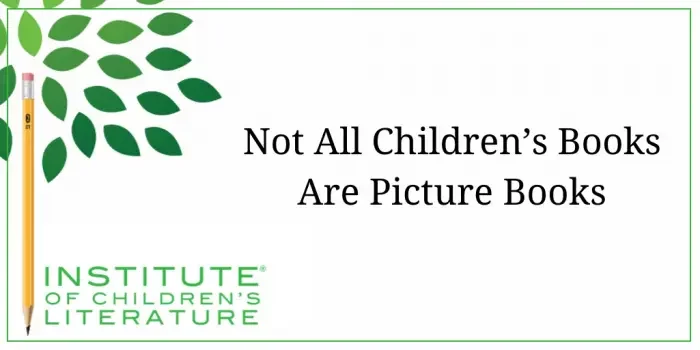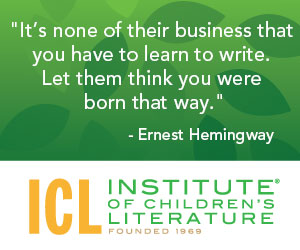1000 N. West Street #1200, Wilmington, DE 19801
© 2024 Direct Learning Systems, Inc. All rights reserved.

For many people new to writing for children, all children’s books are picture books. If you ask them what they are working on, they’ll say, “a children’s book” as if that is all the explanation necessary. And usually what they mean is “a picture book” or (at the very least) a heavily illustrated storybook. It’s for kids, surely it needs to be published between hard covers with lots and lots of brightly colored pictures.

So, do you have a novel-writing brain? Here’s how to find out.
Write down the title of the last twenty books you have read (if you haven’t read twenty that you can think of, just write the ones you can).
Do you find the list novel heavy?
If you’re an adult, you probably do. Book writers tend to grow out of book lovers, and most book lovers read novels in their adult years. The problem with reading mostly novels (or even frequent novels) is that it trains your brain to think of writing in novel-structure ways. And that will tend to hinder your efforts at picture book writing. Honestly, the first thing you need to do to write a picture book well is to go on a month-long “picture book diet” where you read as many picture books each day as you possibly can (a trip to the local book store or public library may be in order.) Count on reading––studying, really––at least 100, and preferably recent publications.
To understand the reason for retraining your writing brain, it may help to look at how a picture book writer will approach a story versus how a novelist or short story writer will approach a story. Imagine I want to write a story about a little boy who acts as if he lives in a musical. He sings all the time. Now, let’s look at a specific moment in the book written by a picture book writer and the same moment written by a short story writer:
Picture book moment: “He sang on the bed.”

How can those both be part of the same story? Well, the first one recognizes that the pajamas, the toothbrush and the pose will always be part of the storytelling the illustrator brings to the book. A good illustrator will think in terms of storytelling across the whole book and will make that moment shine. A great illustrator will include things that tell side stories that you couldn’t possibly put into the main text, but which enhance repeat reads of the book. And a good picture book writer will not try to do the illustrator’s job in the text.
When my daughter was very young, I came home from a conference with a signed copy of Finklehopper Frog. I read it to my little girl. She liked the book, but she loved the story within the story, the one told by the illustrator. She came up with her own ideas for these tiny side character sprinkled in the story by the illustrator, Brian Lies. During the day, she’d even roleplay as one of the tiniest characters on the page (a bug in a wheelchair). Nothing about that bug was in the text, but the inclusion of it was magical for one very little girl. That’s what a great illustrator brings to your picture book: more magic.
But, you say, you don’t want to write in the spare language of the 100 to 500 word picture book. You want to write more like the example with Joey belting out his rockabilly song while clutching his toothbrush in his hand. You want to control the images. You want to make the magic. There’s nothing wrong with that. But it means you probably really want to write something other than a picture book. I know, that probably hurts. You always thought you wanted to write a picture book. You might even remember reading some very, very long picture books when you were a kid. Isn’t anyone doing those? Do you have to self-publish to write the kind of book you want to write where the pictures simply support the text and the illustrator isn’t a storyteller but a kind of visual copyist of your vision?

There are a few publishers who do publish longer picture books (though by “longer,” I tend to mean up to 1200 words, so if your picture book is 2400 words, you’re really back to either recognizing that you have written something other than a picture book or self-publishing). Now, the folks doing longer picture books are often publishing one of the following:
(1) very literary, lyrical work,
(2) historical picture books with a prose style to match the feeling of the period,
(3) picture books that are set in very unique places and bring that location to life, or
(4) nonfiction picture books which are often educational and go by very different word count rules.
So my rollicking story of the little boy who sings his way through the day would be unlikely to sell to one of the publishers doing longer picture books. It is the kind of story that either
(1) is written spare in the more “picture book” style or
(2) is written as a short story.
And I have written fun, rollicking stories as short stories and sold them to magazines (or written them as test passages or written them as samples for my website or to send to publishers). That is also rewarding, but I can understand if you’re really holding out for the picture book.
Picture books are a dance in the dark with a partner (the illustrator) you may never meet or even email with.
Remember rollicking, rockin’ Joey, the boy who sings the day away? Let’s look at a good compromise and begin paring at the prose to make something that is both bouncy and spare:
“On his bed every night, Joey wriggled. He wiggled. He belted out his best bedtime ballad.”
And maybe my next page would be: “It brought down the house.”
I’d have to keep in mind that a picture book is only 32 pages and part of that is front matter (title page and such). So I need to get the story told with a scant number of pages, and that may require some brutality in cutting my little story. But I have to be careful not to cut it back to lifelessness. After all, the acquisitions editor will be seeing only the words on the page when she buys the book. Now a good acquisitions editor will see the illustration potential in those words, but the words need to charm her as well.
You see, picture book writing is hard. And if you wrote one because surely anything that short is easy, you will almost certainly need to work on it a while longer (or else you’re one of those magical people for whom it really is easy. But really, be sure you are.) Picture books are a dance where you’re doing different steps in flawless harmony, and that really is as hard as it sounds. But when it works, it’s magic. And for picture book writers, it’s the magic that makes all the work worth it.
With over 100 books in publication, Jan Fields writes both chapter books for children and mystery novels for adults. She’s also known for a variety of experiences teaching writing, from one session SCBWI events to lengthier Highlights Foundation workshops to these blog posts for the Institute of Children’s Literature. As a former ICL instructor, Jan enjoys equipping writers for success in whatever way she can.
1000 N. West Street #1200, Wilmington, DE 19801
© 2024 Direct Learning Systems, Inc. All rights reserved.
1000 N. West Street #1200, Wilmington, DE 19801
© 2024 Direct Learning Systems, Inc. All rights reserved.
1000 N. West Street #1200, Wilmington, DE 19801
© 2024 Direct Learning Systems, Inc. All rights reserved.
5 Comments